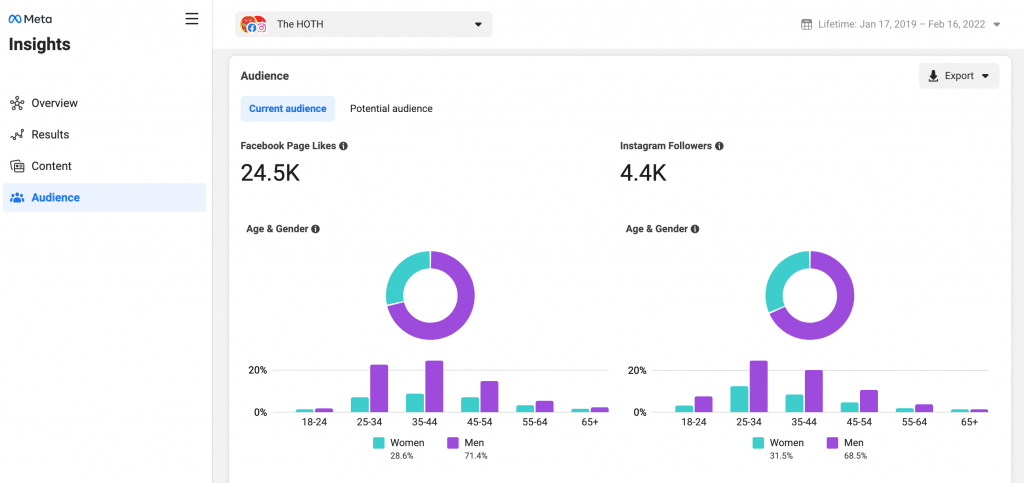Quick Links
Content marketing can sometimes seem like a never-ending slog of blog posts, landing pages, and social media posts. Your goals might be to boost engagement and generate leads, but most companies fall flat.
When your content marketing strategy is disorganized and the topics are random keywords, it’s hard to make an impact.
You need to plan content in a way that supports your business’ larger goals. Content pillars help with this. They give your content a purpose and make it easier to create a content schedule that is more than just a mix of random keywords.
This article will explain what a content pillar is and how pillar content strategies can help marketers drive authority and traffic. We even break down how to use pillar content for your website and social media.

What is a content pillar?
A content pillar is a long-form piece of content that comprehensively covers one main topic and all the sub-topics under it. It provides key information about a broad topic. The page is also optimized for a specific keyword and search intent.
So, how does this help with content marketing and gaining higher rankings on search engine result pages (SERPs)?
First, content marketers create valuable in-depth content about a specific topic. But the real key is to create a “content cluster” around it. A content cluster is a collection of content related to — and directly linking to — your pillar content.
These topic clusters create an interlinked web of content that strengthens your Topical Authority and keeps users on your site for longer.
An SEO strategy focused on content pillars can help you rank for multiple keywords on search engines. Better rankings mean increased brand awareness, traffic, and leads.
Here’s an example of a topic cluster for the keyword “knowledge base”:
There are three main types of pages within the content pillar strategy:
- Main pillar: Over 3,000 words of high-quality, in-depth content focused on a more general primary keyword (that’s well over the average recommended blog post length of 1500-2000 words.)
- Sub-pillar: Posts targeting longer tail keywords related to topics in the central pillar.
- Individual blog posts: Posts covering common long-tail keywords related to the core pillar and cluster topics.
You can also use content pillars for social media marketing. These aren’t as keyword-focused as the pillar pages on your website. Instead, social media content pillars are three to five themes or topics your posts are focused on.
Social media content pillars or content buckets are more generic than a pillar content strategy for your website, but they still simplify ideation and content creation.
Why use a pillar content strategy?
Here’s why you should use a pillar content strategy for your website:
- Improve content organization: All your content is organized into pillars and sub-topics that serve a purpose.
- Boost SEO: Start ranking for important keywords, both short-tail and long-tail (long-form content gets 77.2% more backlinks than short content).
- Develop better content ideas: Use pillar content as a base to create ideas that have an impact on the reader.
- Keep users on your site for longer: Engaged readers will be given multiple opportunities to click on other topics and keep reading for longer.
- Create an effective content marketing system: Create a content marketing strategy where all assets are interconnected and serve a specific purpose on their own.
- Use the right KPIs: Match content with business goals and understand how every piece of content helps achieve them.
How to build a content pillar strategy for your website
You can use these five steps to build a content pillar strategy for your brand’s website:
1. Identify the main topic and keyword
The first step in building a content pillar is determining which topic and keyword you should focus on. To identify this, you need to perform a mix of customer and keyword research.
You need to understand the search intent, aka what users want to know or do when they search for that specific phrase.
Identify your target audience and buyer personas to grasp their pain points and needs. The best way to do this is to interview customers and clients or do surveys.
Now you have a general idea of what your pillar topic should be. Next, use keyword research to find viable sub-topics.
Most keyword research tools include search volume and keyword difficulty. You can also search for the keyword directly in a search engine and browse the “People Also Ask” section.
All of this research will help determine if your main topic warrants a pillar page and topic cluster.
It also helps identify sub-topics. The pillar page will briefly cover the sub-topics, and the cluster pages will go into more detail, with interlinking between them.
2. Audit existing content
List and assess all your existing content to see if it can be optimized or updated to match your pillar content strategy.
A content audit can also help you identify your brand’s focus, which could help define the main topic. You can also repurpose or restructure existing content to fit into a new topic cluster.
Content audits will stop you from repeating content topics and eliminate any redundant pieces. It is also an opportunity to analyze your internal linking strategy.
If you have hundreds or thousands of content pieces, a manual audit might be a lot of work. Instead, you can use free website SEO audit tools.
3. Research your competitors
Once you’ve identified the main topic, it’s time to do more research. There’s a high chance that other brands within your niche or industry are eager to rank for the same or similar topics.
Carry out a competitor analysis to understand their content marketing tactics, as well as determine any gaps that you could fill and areas where you can address the topic better than them.
If you can build a broader and more authoritative guide than your competitors, it can help you beat them in search rankings.
Competitor research helps you see what they’re doing right and what you can improve on. The easiest way to identify their keywords and tactics is to use an SEO Gap Analysis tool.
4. Build your pillar
Now that you have all the information you need, it’s time to create your pillar page. Start by prioritizing all the topics you’ve assembled so far. See how they match up against current customer needs and industry trends.
Your pillar page will start with the main topic and delve into each sub-topic. Once the pillar page is written, optimize it for the relevant keywords, focusing on the search intent.
Add a table of contents at the top of your pillar page — these are long pages after all — and make sure sub-headings include the right semantic keywords. Here’s an example of our page on keyword research:
As you can see, there’s a clear table of contents for users to quickly navigate between topics and even a short explainer video on top for users that prefer video.
Our team also added a CTA and email subscription opt-in to drive topic-specific lead generation.
If we explore the page further, it includes many links to relevant content, tools, products, and visuals to break down concepts. These are standard SEO best practices that help users understand your point and keep them reading more.
There are also other essential elements to keep in mind:
- Add the core topic in your page title and URL.
- Use the main topic in the H1.
- Ensure your table of contents links to the corresponding section.
- Use the main topic in the alt text for images.
- Add a “Back to the top” button.
5. Create your cluster to back up your pillar content
Once your pillar page is ready to go, it’s time to build on it with cluster pages. Set the scope and word count for each blog post based on each keyword and the research you’ve done.
Also include subheadings and various focus keywords in this plan.
Using a content map is great for this step as it acts as a guideline and visualizes all your pillar content.
Create your cluster pages by focusing on high-priority semantic keywords. Optimize each page for search intent and secondary keywords as well.
When both your pillar page and cluster pages are complete, decide how to add internal links between them to create a cohesive experience. You want to lead readers on a journey of valuable information that ends in them purchasing your product or services — interlink between your pages accordingly.
Interlinking between pieces of content is crucial for ranking in the top SERPs. To further establish your pillar as an expert source on the subject, invest in building backlinks from relevant industry sites.
This can be a lot of work, which is why most companies choose to use managed SEO services like The HOTH X.
6. Distribution and promotion
The last stage of your content pillar strategy involves distribution and promotion. Break down the pillar page into smaller pieces, such as infographics, social posts, and videos, and share on various social media channels.
The pillar page should be prominent and easy to find on your website. Other promotion possibilities include:
- Sharing in social communities
- Remarketing campaigns
- Email newsletter
- Collaborating with influencers
- Presentations
- Press release
To capitalize on these opportunities, you must build new creative assets based on the pillar page that are easy to share on social media and in newsletters.
You don’t always have to promote your main pillar. You can promote any post or other content in your topic cluster. After all, all these smaller pages link directly to your pillar page.
Building a pillar content strategy for social media
The process for building pillar content for social media is similar, but there are key differences. Here’s how you can bring your social media pillar content to life:
1. Build a content bank
A content bank is a collection of all your ideas. These ideas must revolve around the three to five main topics your brand is geared toward.
To build a content bank, start by analyzing your target audience to understand:
- The platforms they use most
- The topics they are interested in
- Topics that provide value or address pain points
- How they consume content
Most social platforms also have analytics built-in to help you explore your audience, for example, Facebook’s Audience Insights:
After answering those questions, look at your current analytics to see what’s working. Which posts are getting the most impressions, what kind of posts are garnering the most engagement, current trends, and more.
You can list the best-performing posts so far and see what they’re focused on, the hashtags you used, the visuals, and the captions. Your future posts can use a similar format.
At this point, you probably have an idea about the topics that you should cover. Then explore the topics and relevant influencers to find the angles and hashtags you should be using. But you don’t have to use existing hashtags — you can also come up with your own.
Finally, look at the overall industry and your main competitors. This solidifies your ideas, helps you adhere to current industry trends, and brainstorm new ones.
For example, a haircare brand can capitalize on the current trend of cruelty-free products. They can create posts to promote relevant products and posts to take advantage of this trend.
Your content bank should focus on your core pillar topics, but you can also include a section for new potential areas.
2. Repurpose existing content
List and categorize your existing posts to see if they match your core topics. If a post covers the core topic or a sub-topic, see if you optimize or update it to meet your new standards.
If your posts are too old but contribute to your core topic, then you update them with better visuals, captions, hashtags, up-to-date stats, etc.
Even if posts fall outside your pillars, you can use them to generate new ideas.
For example, if the format of an older post was effective, but the information and visuals are outdated, you can experiment with the same format for newer posts.
You can repurpose content from existing pillar pages on your website by breaking them down into bite-sized, social-media-friendly content types — for example, infographics, images, charts, and videos.
3. Create content calendar
Build a content calendar with your posts for the next few weeks. A social media content calendar is similar to an editorial one.
It lists all the content going out over a period (usually a month), their publishing dates, and any relevant notes.
This is what a basic monthly content calendar looks like:
You can use online tools to create more detailed and customized calendars for social media.
Ideally, the social media posts should incorporate links to long-form content, such as a pillar page, YouTube video, or blog post.
Focus on important dates, posts, and links to your other long-form content. If you’re using multiple platforms, your content calendar can also include blog posts and YouTube videos.
4. Schedule your posts in advance
Consistently sharing pillar content on social media is easier when you can schedule all your posts in advance.
Use social media scheduling platforms — like Buffer — that let you plan and preview your content across multiple social channels in one place. That lets you use automation to publish your posts on time automatically.
Don’t just schedule and forget about your posts. You should constantly update your content calendar to keep up with trends.
After all, you want posts that can capture your target audience’s attention. You also don’t want to post something that’s become offensive or against audience sentiment.
Most scheduling tools let you preview and edit posts in advance, so you can instantly edit one or more posts based on the latest news.
Scheduling your posts in advance helps you catch errors and maintain a cohesive content strategy, where social media posts and other content align. Scheduling also gives you more time to focus on other aspects of your marketing strategy.
5. Create an integrated content pillar strategy
Your social media and website pillar content should form a cohesive ecosystem where each promotes the other — all with the end goal of lead generation and conversions.
A disjointed or scattered content strategy can leave readers confused. You could end up with the perfect social media post, but the link could be to content that has nothing to do with the post itself. It’s important to align the messaging and topics across all your marketing channels.
When there’s a cohesive content distribution plan in place, your social media pillars will lead audiences to your website pillars or sub-topics. These pages will then lead prospects further down the sales funnel.
Conclusion
Content pillars can elevate your marketing efforts by creating informative guides that provide real value to your readers. They also create a cohesive experience for visitors and are great for SEO.
However, content planning, creating pillar and cluster pages, optimizing for SEO, and effective content distribution can be challenging for most businesses. If you want help with strategy, planning, as well as creating and optimizing the content, look no further than HOTH X, our managed SEO service. Book a call today.
















